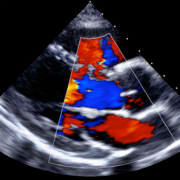
EchoLab
Analysis for echocardiography
开发者: Medical Appware, LLC
64天13小时
最新版本上线距今
2
近1年版本更新次数
2011-04-04
全球最早版本上线日期
版本: 11.1
版本更新日期
2024-08-15

EchoLab
Analysis for echocardiography
更新日志
• New calculation added for estimation of the pulmonary capillary wedge pressure (PCWP) from the left atrial volume index, the mitral inflow E-wave velocity, and the pulmonary venous systolic velocity.
• Hemodynamics view updated to include PCWP estimated with 3 different methods.
• Enhanced evaluation of shock states in the Analytic Engine (cardiogenic, distributive, and hypovolemic shock), using the cardiac index, PCWP, and systemic vascular resistance.
• Continued refinement of the Analytic Engine.
EchoLab is optimized for Dark Mode, ideal for use in the dimmed lighting of a typical echocardiography reading room.
Remember that designating Quick Entry views as favorites permits easy access to frequently used echocardiographic measurements under the Favorites tab.
Consider making the Demographics and Clinical Conditions view into a favorite to ensure that the Analytic Engine accounts for relevant clinical factors.
Check out the bundled Apple Watch app for EchoLab, providing a ready reference when performing echocardiograms.视频/截图
应用描述
EchoLab presents the formulas and algorithms used in an adult echocardiography laboratory. Designed by a practicing cardiologist, EchoLab provides a comprehensive framework for teaching the principles of quantitative echocardiography, or cardiac ultrasound. EchoLab's unique design permits sharing of entered and calculated data between its many formulas. Quick Entry views provide immediate access to a wide array of echocardiographic calculations.
Unique to EchoLab among echocardiography applications is the powerful Analytic Engine, which synthesizes results from multiple calculations into a cohesive overview with a comprehensive summary, with integration of ASE/EACVI guidelines. The included companion app for the Apple Watch provides a ready reference when performing or interpreting echocardiograms.
Available with each calculation is a graphical display of the corresponding mathematical equation, along with tips for using the calculation and medical literature references with integrated hyperlinks.
Calculations and analyses include:
• Aortic effective regurgitant orifice area
• Aortic energy loss index
• Aortic flow acceleration time with ratio to left ventricular ejection time
• Aortic prosthetic paravalvular regurgitant extent
• Aortic regurgitant fraction
• Aortic regurgitant jet width, jet area, pressure half-time, and vena contracta
• Aortic regurgitation index (for TAVR, from invasive pressure measurements)
• Aortic root assessment
• Aortic transvalvular flow rate
• Aortic valve area (from velocity and velocity-time integrals, including dobutamine stress with projected aortic valve area)
• Aortic valve resistance
• Aortic valvulo-arterial impedance (Zva)
• Biventricular coupling index
• Body mass index
• Body surface area
• Cardiac output and ejection fraction (3D, area-length, Doppler, Dumesnil, Teichholz, simplified Quinones, and Simpson's methods)
• Diastolic assessment (using either 2009 or 2016 guidelines for analysis)
• Diastolic stress echocardiography
• echocardiographic Pulmonary to Left Atrial Ratio (ePLAR)
• Exercise stress echocardiography
• Hemodynamic summary
• Left atrial appendage emptying velocity
• Left atrial pressure
• Left atrial expansion index, function index, and reservoir strain
• Left and right atrial volume and index
• Left ventricular diastolic diameter index
• Left ventricular dP/dt
• Left ventricular fractional shortening
• Left ventricular GLS
• Left ventricular mass, mass index, and relative wall thickness
• Left ventricular myocardial performance index
• Left ventricular stroke work loss
• Left ventricular wall motion score index
• Maximum predicted heart rate (for dobutamine and exercise stress)
• Maximum rate-pressure product (for exercise stress)
• Mean arterial pressure
• Mitral effective orifice area (PISA and stroke volume methods)
• Mitral regurgitant fraction (PISA and stroke volume methods)
• Mitral regurgitant vena contracta
• Mitral valve area (continuity, PISA, and pressure half-time methods)
• Mitral valve resistance
• Mitral valvuloplasty score
• Pericardial effusion (size and flow velocity paradoxus)
• Prosthetic aortic and mitral valve assessment
• Pulmonary artery systolic pressure (using tricuspid regurgitant velocity, VSD flow velocity, or pulmonary artery acceleration time), diastolic pressure, and mean pressure
• Pulmonary capillary wedge pressure
• Pulmonary vascular resistance
• Right atrial pressure
• Right ventricular-arterial coupling
• Right ventricular function: dP/dt, fractional area change, free wall strain, index of myocardial performance, lateral annular plane systolic excursion, size, and tricuspid annular plane systolic excursion (TAPSE)
• Shunt ratio (Qp:Qs)
• Systemic vascular resistance
• Tricuspid regurgitant vena contracta
• Tricuspid valve area (pressure half-time method)
EchoLab is a teaching and reference application, not a tool for clinical diagnosis, clinical decision-making, or echocardiography report generation.版本: 11.0
版本更新日期
2024-05-24

EchoLab
Analysis for echocardiography
更新日志
Several new calculations and analyses:
• Left ventricular wall motion score index added to “Left Ventricle” category, along with semi-quantitative calculation of the left ventricular ejection fraction. Toggle switch shows typical coronary artery perfusion for each left ventricular wall segment.
• Biventricular coupling index added to “Pulmonary Artery” category for helping to distinguish precapillary from postcapillary pulmonary hypertension.
• Left atrial appendage emptying velocity added to “Atria” category for prediction of atrial fibrillation after cryptogenic stroke.
Additional new features:
• Demographics and Clinical Conditions view modified to include a toggle switch for atrial fibrillation, enhancing assessment by the Analytic Engine when this rhythm is present. Consider making this view one of your favorites for easy access, since once the patient’s sex is designated here, it no longer is necessary to specify the sex when utilizing the Analytic Engine.
• Right atrial pressure view modified to permit 3 different ways to enter mean right atrial pressure.
• Many refinements of the Analytic Engine.
• Updated list of echocardiography and cardiology organizations. expanded to 79 direct links, found under “Organizations” using the “?” button at the top right of the opening app screen.
EchoLab is optimized for Dark Mode, ideal for use in the dimmed lighting of a typical echocardiography reading room.
Remember that designating Quick Entry views as favorites permits easy access to the most frequently used echocardiographic measurements under the Favorites tab.
Remember also to check out the bundled Apple Watch app for EchoLab, providing a ready reference when performing echocardiograms.应用描述
暂无应用描述数据
版本: 10.0
版本更新日期
2023-04-04

EchoLab
Analysis for echocardiography
更新日志
An extensive update with a focus on left atrial function:
• New calculations and analyses for left atrial emptying fraction, left atrial expansion index, left atrial function index, and left atrial reservoir strain.
• New calculation of pulmonary capillary wedge pressure (PCWP) from the left atrial expansion index.
• Left Atrial Volume and Function view modified for entry of maximum and minimum left atrial volumes.
• Analytic Engine updated to assess risk of developing atrial fibrillation, based on echocardiographic parameters.
Additional new features:
• New Demographics and Clinical Conditions view added to allow rapid baseline data entry and designation of conditions affecting data analysis (such as presence of a valve prosthesis). Consider making this view one of your favorites for easy access, since once the patient’s sex is designated here, it no longer is necessary to specify the sex when utilizing the Analytic Engine.
• Right ventricular free wall strain added to right ventricular assessment.
• Strain Imaging added as a new view category for data entry.
• Multiple refinements of the Analytic Engine, including enhanced assessment of hypertrophic cardiomyopathy.
• List of echocardiography and cardiology organizations expanded to over 70 direct links, found under “Organizations” using the “?” button at the top right of the initial app screen.
EchoLab is optimized for Dark Mode, ideal for use in the dimmed lighting of a typical echocardiography reading room.
Remember that designating Quick Entry views as favorites permits easy access to the most frequently used echocardiographic measurements under the Favorites tab.
Remember also to check out the bundled Apple Watch app for EchoLab, providing a ready reference when performing echocardiograms.视频/截图
应用描述
EchoLab presents the formulas and algorithms used daily in an adult echocardiography laboratory. Designed by a practicing cardiologist and echocardiographer, EchoLab provides a comprehensive framework for teaching the principles of quantitative echocardiography, or cardiac ultrasound. EchoLab's unique design permits sharing of entered and calculated data between its many formulas, with no need to re-enter data when shifting to a new calculation. Quick Entry views provide immediate access to a wide array of echocardiographic calculations to fuel the Analytic Engine.
Unique to EchoLab among echocardiography applications is the powerful Analytic Engine, which synthesizes results from multiple calculations into a cohesive overview with a comprehensive summary, with integration of ASE/EACVI guidelines. The included companion app for the Apple Watch provides a ready reference when performing or interpreting echocardiograms.
Available with each calculation is a graphical display of the corresponding mathematical equation, along with tips for using the calculation and medical literature references with integrated hyperlinks.
Calculations and analyses include:
• Aortic effective regurgitant orifice area
• Aortic energy loss index
• Aortic flow acceleration time with ratio to left ventricular ejection time
• Aortic prosthetic paravalvular regurgitant extent
• Aortic regurgitant fraction
• Aortic regurgitant jet width, jet area, pressure half-time, and vena contracta
• Aortic regurgitation index (for TAVR, from invasive pressure measurements)
• Aortic root assessment
• Aortic transvalvular flow rate
• Aortic valve area (from velocity and velocity-time integrals, including dobutamine stress with projected aortic valve area)
• Aortic valve resistance
• Aortic valvulo-arterial impedance (Zva)
• Body mass index
• Body surface area
• Cardiac output and ejection fraction (3D, area-length, Doppler, Dumesnil, Teichholz, simplified Quinones, and Simpson's methods)
• Diastolic assessment (using either 2009 or 2016 guidelines for analysis)
• Diastolic stress echocardiography
• echocardiographic Pulmonary to Left Atrial Ratio (ePLAR)
• Exercise stress echocardiography
• Hemodynamic summary
• Left atrial pressure
• Left atrial expansion index, function index, and reservoir strain
• Left and right atrial volume and index
• Left ventricular diastolic diameter index
• Left ventricular dP/dt
• Left ventricular fractional shortening
• Left ventricular GLS
• Left ventricular mass, mass index, and relative wall thickness
• Left ventricular myocardial performance index
• Left ventricular stroke work loss
• Maximum predicted heart rate (for dobutamine and exercise stress)
• Maximum rate-pressure product (for exercise stress)
• Mean arterial pressure
• Mitral effective orifice area (PISA and stroke volume methods)
• Mitral regurgitant fraction (PISA and stroke volume methods)
• Mitral regurgitant vena contracta
• Mitral valve area (continuity, PISA, and pressure half-time methods)
• Mitral valve resistance
• Mitral valvuloplasty score
• Pericardial effusion (size and flow velocity paradoxus)
• Prosthetic aortic and mitral valve assessment
• Pulmonary artery systolic pressure (using tricuspid regurgitant velocity, VSD flow velocity, or pulmonary artery acceleration time), diastolic pressure, and mean pressure
• Pulmonary capillary wedge pressure
• Pulmonary vascular resistance
• Right atrial pressure
• Right ventricular-arterial coupling
• Right ventricular function: dP/dt, fractional area change, free wall strain, index of myocardial performance, lateral annular plane systolic excursion, size, and tricuspid annular plane systolic excursion (TAPSE)
• Shunt ratio (Qp:Qs)
• Systemic vascular resistance
• Tricuspid regurgitant vena contracta
• Tricuspid valve area (pressure half-time method)
EchoLab is a teaching and reference application, not a tool for clinical diagnosis, clinical decision-making, or echocardiography report generation.版本: 9.0.1
版本更新日期
2022-05-22

EchoLab
Analysis for echocardiography
更新日志
• Minor update to expand display for height and weight to 2 decimal places, along with expanded decimal used internally for conversion of pounds to kilograms.
New to EchoLab version 9.0:
• All literature references, provided for each calculation, now include hyperlinks for direct internet access.
• Literature references updated to include the latest societal guidelines.
• New Aortic Valvulo-Arterial Impedance view added to the Aortic Valve section as an additional parameter for assessing aortic stenosis.
• New Right Ventricular-Arterial Coupling view added to the Right Ventricle section as an additional parameter for assessing right ventricular contractile reserve in the presence of pulmonary hypertension.
• Links to cardiology and echocardiography organizations updated in the Guides and Resources section.
EchoLab is optimized for iOS 15 with Dark Mode, ideal for use in the dimmed lighting of a typical echocardiography reading room.
Remember that designating Quick Entry views as favorites permits easy access to the most frequently used echocardiographic measurements under the Favorites tab.
Remember also to check out the bundled Apple Watch app for EchoLab, providing a ready reference when performing echocardiograms.视频/截图
应用描述
EchoLab presents the formulas and algorithms used daily in the adult echocardiography laboratory. Designed by a practicing cardiologist and echocardiographer, EchoLab provides a comprehensive framework for teaching the principles of quantitative echocardiography, or cardiac ultrasound. EchoLab's unique design permits sharing of entered and calculated data between its many formulas, with no need to re-enter data when shifting to a new calculation. Quick Entry views provide immediate access to a wide array of echocardiographic calculations to fuel the Analytic Engine.
Unique to EchoLab among echocardiography applications is the powerful Analytic Engine, which synthesizes results from multiple calculations into a cohesive overview with a comprehensive summary, with integration of ASE/EACVI guidelines. The included companion app for the Apple Watch provides a ready reference when performing or interpreting echocardiograms.
EchoLab displays all data with an assessment of each variable as normal or abnormal by adult criteria. Available with each formula is a graphical display of the corresponding mathematical equation, along with tips for using the calculation and medical literature references with integrated hyperlinks.
Calculations and analyses include:
• Aortic effective regurgitant orifice area
• Aortic energy loss index
• Aortic flow acceleration time with ratio to left ventricular ejection time
• Aortic prosthetic paravalvular regurgitant extent
• Aortic regurgitant fraction
• Aortic regurgitant jet width, jet area, pressure half-time, and vena contracta
• Aortic regurgitation index (for TAVR, from invasive pressure measurements)
• Aortic root assessment
• Aortic transvalvular flow rate
• Aortic valve area (from velocity and velocity-time integrals, including dobutamine stress with projected aortic valve area)
• Aortic valve resistance
• Aortic valvulo-arterial impedance (Zva)
• Body mass index
• Body surface area
• Cardiac output and ejection fraction (3D, area-length, Doppler, Dumesnil, Teichholz, simplified Quinones, and Simpson's methods)
• Diastolic assessment (using either 2009 or 2016 guidelines for analysis)
• Diastolic stress echocardiography
• echocardiographic Pulmonary to Left Atrial Ratio (ePLAR)
• Exercise stress echocardiography
• Hemodynamic summary
• Left atrial pressure
• Left and right atrial volume and index
• Left ventricular diastolic diameter index
• Left ventricular dP/dt
• Left ventricular fractional shortening
• Left ventricular GLS
• Left ventricular mass, mass index, and relative wall thickness
• Left ventricular myocardial performance index
• Left ventricular stroke work loss
• Maximum predicted heart rate (for dobutamine and exercise stress)
• Maximum rate-pressure product (for exercise stress)
• Mean arterial pressure
• Mitral effective orifice area (PISA and stroke volume methods)
• Mitral regurgitant fraction (PISA and stroke volume methods)
• Mitral regurgitant vena contracta
• Mitral valve area (continuity, PISA, and pressure half-time methods)
• Mitral valve resistance
• Mitral valvuloplasty score
• Pericardial effusion (size and flow velocity paradoxus)
• Prosthetic aortic and mitral valve assessment
• Pulmonary artery systolic pressure (using tricuspid regurgitant velocity, VSD flow velocity, or pulmonary artery acceleration time), diastolic pressure, and mean pressure
• Pulmonary capillary wedge pressure
• Pulmonary vascular resistance
• Right atrial pressure
• Right ventricular-arterial coupling
• Right ventricular function: dP/dt, fractional area change, index of myocardial performance, lateral annular plane systolic excursion, size, and tricuspid annular plane systolic excursion (TAPSE)
• Shunt ratio (Qp:Qs)
• Systemic vascular resistance
• Tricuspid regurgitant vena contracta
• Tricuspid valve area (pressure half-time method)
EchoLab is a teaching and reference application, not a tool for clinical diagnosis, clinical decision-making, or echocardiography report generation.版本: 9.0
版本更新日期
2022-05-01

EchoLab
Analysis for echocardiography
更新日志
• All literature references in the app, provided for each calculation, now include hyperlinks for direct internet access.
• Literature references updated to include the latest societal guidelines.
• New Aortic Valvulo-Arterial Impedance view added to the Aortic Valve section as an additional parameter for assessing aortic stenosis.
• New Right Ventricular-Arterial Coupling view added to the Right Ventricle section as an additional parameter for assessing right ventricular contractile reserve in the presence of pulmonary hypertension.
• Links to cardiology and echocardiography organizations updated in the Guides and Resources section.
EchoLab is optimized for iOS 15 with Dark Mode, ideal for use in the dimmed lighting of a typical echocardiography reading room.
Remember that designating Quick Entry views as favorites permits easy access to the most frequently used echocardiographic measurements under the Favorites tab.
Remember also to check out the bundled Apple Watch app for EchoLab, providing a ready reference when performing echocardiograms.视频/截图
应用描述
EchoLab presents the formulas and algorithms used daily in the adult echocardiography laboratory. Designed by a practicing cardiologist and echocardiographer, EchoLab provides a comprehensive framework for teaching the principles of quantitative echocardiography, or cardiac ultrasound. EchoLab's unique design permits sharing of entered and calculated data between its many formulas, with no need to re-enter data when shifting to a new calculation. Quick Entry views provide immediate access to a wide array of echocardiographic calculations to fuel the Analytic Engine.
Unique to EchoLab among echocardiography applications is the powerful Analytic Engine, which synthesizes results from multiple calculations into a cohesive overview with a comprehensive summary, with integration of ASE/EACVI guidelines. The included companion app for the Apple Watch provides a ready reference when performing or interpreting echocardiograms.
EchoLab displays all data with an assessment of each variable as normal or abnormal by adult criteria. Available with each formula is a graphical display of the corresponding mathematical equation, along with tips for using the calculation and medical literature references with integrated hyperlinks.
Calculations and analyses include:
• Aortic effective regurgitant orifice area
• Aortic energy loss index
• Aortic flow acceleration time with ratio to left ventricular ejection time
• Aortic prosthetic paravalvular regurgitant extent
• Aortic regurgitant fraction
• Aortic regurgitant jet width, jet area, pressure half-time, and vena contracta
• Aortic regurgitation index (for TAVR, from invasive pressure measurements)
• Aortic root assessment
• Aortic transvalvular flow rate
• Aortic valve area (from velocity and velocity-time integrals, including dobutamine stress with projected aortic valve area)
• Aortic valve resistance
• Aortic valvulo-arterial impedance (Zva)
• Body mass index
• Body surface area
• Cardiac output and ejection fraction (3D, area-length, Doppler, Dumesnil, Teichholz, simplified Quinones, and Simpson's methods)
• Diastolic assessment (using either 2009 or 2016 guidelines for analysis)
• Diastolic stress echocardiography
• echocardiographic Pulmonary to Left Atrial Ratio (ePLAR)
• Exercise stress echocardiography
• Hemodynamic summary
• Left atrial pressure
• Left and right atrial volume and index
• Left ventricular diastolic diameter index
• Left ventricular dP/dt
• Left ventricular fractional shortening
• Left ventricular GLS
• Left ventricular mass, mass index, and relative wall thickness
• Left ventricular myocardial performance index
• Left ventricular stroke work loss
• Maximum predicted heart rate (for dobutamine and exercise stress)
• Maximum rate-pressure product (for exercise stress)
• Mean arterial pressure
• Mitral effective orifice area (PISA and stroke volume methods)
• Mitral regurgitant fraction (PISA and stroke volume methods)
• Mitral regurgitant vena contracta
• Mitral valve area (continuity, PISA, and pressure half-time methods)
• Mitral valve resistance
• Mitral valvuloplasty score
• Pericardial effusion (size and flow velocity paradoxus)
• Prosthetic aortic and mitral valve assessment
• Pulmonary artery systolic pressure (using tricuspid regurgitant velocity, VSD flow velocity, or pulmonary artery acceleration time), diastolic pressure, and mean pressure
• Pulmonary capillary wedge pressure
• Pulmonary vascular resistance
• Right atrial pressure
• Right ventricular-arterial coupling
• Right ventricular function: dP/dt, fractional area change, index of myocardial performance, lateral annular plane systolic excursion, size, and tricuspid annular plane systolic excursion (TAPSE)
• Shunt ratio (Qp:Qs)
• Systemic vascular resistance
• Tricuspid regurgitant vena contracta
• Tricuspid valve area (pressure half-time method)
EchoLab is a teaching and reference application, not a tool for clinical diagnosis, clinical decision-making, or echocardiography report generation.版本: 8.1
版本更新日期
2021-08-06

EchoLab
Analysis for echocardiography
更新日志
• New Constrictive Pericarditis versus Restrictive Cardiomyopathy view integrates this portion of the 2016 ASE/EACVI diastology guidelines into the Analytic Engine. An Ancillary Findings button appears for entry of additional data if restrictive physiology is possible.
• Deprecated 2009 ASE diastology assessment removed as an option from the Analytic Engine, which now exclusively uses the 2016 ASE/EACVI diastology guidelines in the Quick Entry (diastology) view.
• Quick Entry (diastology) view now includes:
• Entry of mitral inflow L-wave velocity, which, if abnormal, suggests a pseudonormal diastolic filling pattern.
• Toggle switch to signify the presence of left bundle branch block or ventricular pacing, which, if present, may affect the diastolic assessment.
• Button for direct access to the new Constrictive Pericarditis versus Restrictive Cardiomyopathy view.
EchoLab is optimized for iOS 14 with Dark Mode, ideal for use in the dimmed lighting of a typical echocardiography reading room.
Remember that designating Quick Entry views as favorites permits easy access to the most frequently used echocardiographic measurements under the Favorites tab.
Remember also to check out the bundled Apple Watch app for EchoLab, providing a ready reference when performing echocardiograms.视频/截图
应用描述
EchoLab presents the formulas and algorithms used daily in the adult echocardiography laboratory. Designed by a practicing cardiologist and echocardiographer, EchoLab provides a comprehensive framework for teaching the principles of quantitative echocardiography, or cardiac ultrasound. EchoLab's unique design permits sharing of entered and calculated data between its many formulas, with no need to re-enter data when shifting to a new calculation. Quick Entry views provide immediate access to a wide array of echocardiographic calculations to fuel the Analytic Engine.
Unique to EchoLab among echocardiography applications is the powerful Analytic Engine, which synthesizes results from multiple calculations into a cohesive overview with a comprehensive summary, with integration of 2015 ASE/EACVI cardiac chamber quantification guidelines and 2016 ASE/EACVI diastolic function guidelines. The included companion app for the Apple Watch provides a ready reference when performing or interpreting echocardiograms.
EchoLab displays all data with an assessment of each variable as normal or abnormal by adult criteria. Available with each formula is a graphical display of the corresponding mathematical equation, along with tips for using the calculation and medical literature references.
Calculations and analyses include:
• Aortic effective regurgitant orifice area
• Aortic energy loss index
• Aortic flow acceleration time with ratio to left ventricular ejection time
• Aortic prosthetic paravalvular regurgitant extent
• Aortic regurgitant fraction
• Aortic regurgitant jet width, jet area, pressure half-time, and vena contracta
• Aortic regurgitation index (for TAVR, from invasive pressure measurements)
• Aortic root assessment
• Aortic transvalvular flow rate
• Aortic valve area (from velocity and velocity-time integrals, including dobutamine stress with projected aortic valve area)
• Aortic valve resistance
• Body mass index
• Body surface area
• Cardiac output and ejection fraction (3D, area-length, Doppler, Dumesnil, Teichholz, simplified Quinones, and Simpson's methods)
• Diastolic assessment (using either 2009 or 2016 guidelines for analysis)
• Diastolic stress echocardiography
• echocardiographic Pulmonary to Left Atrial Ratio (ePLAR)
• Exercise stress echocardiography
• Hemodynamic summary
• Left atrial pressure
• Left and right atrial volume and index
• Left ventricular diastolic diameter index
• Left ventricular dP/dt
• Left ventricular fractional shortening
• Left ventricular GLS
• Left ventricular mass, mass index, and relative wall thickness
• Left ventricular myocardial performance index
• Left ventricular stroke work loss
• Maximum predicted heart rate (for dobutamine and exercise stress)
• Maximum rate-pressure product (for exercise stress)
• Mean arterial pressure
• Mitral effective orifice area (PISA and stroke volume methods)
• Mitral regurgitant fraction (PISA and stroke volume methods)
• Mitral regurgitant vena contracta
• Mitral valve area (continuity, PISA, and pressure half-time methods)
• Mitral valve resistance
• Mitral valvuloplasty score
• Pericardial effusion (size and flow velocity paradoxus)
• Prosthetic aortic and mitral valve assessment
• Pulmonary artery systolic pressure (using tricuspid regurgitant velocity, VSD flow velocity, or pulmonary artery acceleration time), diastolic pressure, and mean pressure
• Pulmonary capillary wedge pressure
• Pulmonary vascular resistance
• Right atrial pressure
• Right ventricular function: dP/dt, fractional area change, index of myocardial performance, lateral annular plane systolic excursion, size, and tricuspid annular plane systolic excursion (TAPSE)
• Shunt ratio (Qp:Qs)
• Systemic vascular resistance
• Tricuspid regurgitant vena contracta
• Tricuspid valve area (pressure half-time method)
EchoLab is a teaching and reference application, not a tool for clinical diagnosis, clinical decision-making, or echocardiography report generation.版本: 8.0
版本更新日期
2021-01-23

EchoLab
Analysis for echocardiography
更新日志
• New Exercise Stress Echocardiography (ESE) view permits calculation and analysis from echocardiographic measurements obtained at peak exercise for assessment of non-ischemic heart disease.
You can open the ESE view directly from the new Stress Echocardiography category, or with the “Exercise stress” button in the following views:
• Cardiac Output (Teichholz)
• Mitral ERO Area (PISA)
• Quick Entry (aortic regurgitation)
• Quick Entry (aortic stenosis)
• Quick Entry (left heart)
• Quick Entry (mitral regurgitation)
• Quick Entry (mitral stenosis)
• Quick Entry (pulmonary hypertension)
• Quick Entry (right heart)
• Quick Entry (standard)
The ESE view has numerous possible data entries in the top half and calculation results in the bottom half. As a helpful guide, relevant fields are highlighted if the ESE view is opened using the “Exercise stress” button in one of the views above. For example, if you first go to Quick Entry (mitral regurgitation) and then use the “Exercise stress” button to open the ESE view, then all of the input and output fields in the ESE view relevant to the evaluation of mitral regurgitation at peak exercise are highlighted. Relevant input fields have a thick white or green border (depending on whether there is active data), and relevant output fields have a yellow border.
As in all views in EchoLab, the “Analyze” button at the bottom left generates an analysis that integrates data from all views, including the ESE view.
• New Diastolic Stress Echocardiography view added to the Left Ventricle and Stress Echocardiography categories, with peak-exercise diastolic Doppler measurements provided for the Analytic Engine.
• echocardiographic Pulmonary to Left Atrial Ratio (ePLAR) view in the Pulmonary Artery category enhanced with a clarified assessment statement and with a link to the pulmonary artery mean pressure calculation.
• Aortic transvalvular flow rate added to the set of calculations in Aortic Valve Area (VTI) and to the Analytic Engine as an additional parameter for evaluation of aortic stenosis.
• Left Atrial Volume calculation and Quick Entry views with left atrial measurement entry updated to allow a choice of area-length, disk summation, and 3D methods to use in the Analytic Engine.
• Separate “Left Ventricular Diastology” section added to output from the Analytic Engine.
• Quick Entry (basic) view re-named as Quick Entry (standard), containing all of the measurements in a standard transthoracic echocardiogram.
• Bundled EchoLab app for the Apple Watch enhanced with new sections for exercise stress and diastolic stress echocardiography.
• “Organizations” section of the EchoLab in-app Guide expanded to include links to 30 echocardiography-related entities worldwide.
• Listed reference ranges for left ventricular mass index corrected to show linear measurement ranges, not 2D measurement ranges (Analytic Engine has been using linear ranges for assessment of left ventricular mass, as intended).
• Deprecated 2014/2017 ACC/AHA guidelines for valvular heart disease removed from the Analytic Engine.
EchoLab is optimized for iOS 14 with Dark Mode, ideal for use in the dimmed lighting of a typical echocardiography reading room.
Remember that designating Quick Entry views as favorites permits easy access to the most frequently used echocardiographic measurements under the Favorites tab.
Remember also to check out the bundled Apple Watch app for EchoLab, providing a ready reference when performing echocardiograms.视频/截图
应用描述
EchoLab presents the formulas and algorithms used daily in the adult echocardiography laboratory. Designed by a practicing cardiologist and echocardiographer, EchoLab provides a comprehensive framework for teaching the principles of quantitative echocardiography, or cardiac ultrasound. EchoLab's unique design permits sharing of entered and calculated data between its many formulas, with no need to re-enter data when shifting to a new calculation. Quick Entry views provide immediate access to a wide array of echocardiographic calculations to fuel the Analytic Engine.
Unique to EchoLab among echocardiography applications is the powerful Analytic Engine, which synthesizes results from multiple calculations into a cohesive overview with a comprehensive summary, with integration of 2015 ASE/EACVI cardiac chamber quantification guidelines and 2016 ASE/EACVI diastolic function guidelines. The included companion app for the Apple Watch provides a ready reference when performing or interpreting echocardiograms.
EchoLab displays all data with an assessment of each variable as normal or abnormal by adult criteria. Available with each formula is a graphical display of the corresponding mathematical equation, along with tips for using the calculation and medical literature references.
Calculations and analyses include:
• Aortic effective regurgitant orifice area
• Aortic energy loss index
• Aortic flow acceleration time with ratio to left ventricular ejection time
• Aortic prosthetic paravalvular regurgitant extent
• Aortic regurgitant fraction
• Aortic regurgitant jet width, jet area, pressure half-time, and vena contracta
• Aortic regurgitation index (for TAVR, from invasive pressure measurements)
• Aortic root assessment
• Aortic transvalvular flow rate
• Aortic valve area (from velocity and velocity-time integrals, including dobutamine stress with projected aortic valve area)
• Aortic valve resistance
• Body mass index
• Body surface area
• Cardiac output and ejection fraction (3D, area-length, Doppler, Dumesnil, Teichholz, simplified Quinones, and Simpson's methods)
• Diastolic assessment (using either 2009 or 2016 guidelines for analysis)
• Diastolic stress echocardiography
• echocardiographic Pulmonary to Left Atrial Ratio (ePLAR)
• Exercise stress echocardiography
• Hemodynamic summary
• Left atrial pressure
• Left and right atrial volume and index
• Left ventricular diastolic diameter index
• Left ventricular dP/dt
• Left ventricular fractional shortening
• Left ventricular GLS
• Left ventricular mass, mass index, and relative wall thickness
• Left ventricular myocardial performance index
• Left ventricular stroke work loss
• Maximum predicted heart rate (for dobutamine and exercise stress)
• Maximum rate-pressure product (for exercise stress)
• Mean arterial pressure
• Mitral effective orifice area (PISA and stroke volume methods)
• Mitral regurgitant fraction (PISA and stroke volume methods)
• Mitral regurgitant vena contracta
• Mitral valve area (continuity, PISA, and pressure half-time methods)
• Mitral valve resistance
• Mitral valvuloplasty score
• Pericardial effusion (size and flow velocity paradoxus)
• Prosthetic aortic and mitral valve assessment
• Pulmonary artery systolic pressure (using tricuspid regurgitant velocity, VSD flow velocity, or pulmonary artery acceleration time), diastolic pressure, and mean pressure
• Pulmonary capillary wedge pressure
• Pulmonary vascular resistance
• Right atrial pressure
• Right ventricular function: dP/dt, fractional area change, index of myocardial performance, lateral annular plane systolic excursion, size, and tricuspid annular plane systolic excursion (TAPSE)
• Shunt ratio (Qp:Qs)
• Systemic vascular resistance
• Tricuspid regurgitant vena contracta
• Tricuspid valve area (pressure half-time method)
EchoLab is a teaching and reference application, not a tool for clinical diagnosis, clinical decision-making, or echocardiography report generation.版本: 7.2
版本更新日期
2020-06-11

EchoLab
Analysis for echocardiography
更新日志
• echocardiographic Pulmonary to Left Atrial Ratio (ePLAR) added to the Pulmonary Artery category as a new calculation, providing an assessment of the transpulmonary gradient in the presence of pulmonary hypertension.
• Analytic Engine enhanced to provide assessment of pulmonary hypertension as precapillary or postcapillary, utilizing ePLAR, pulmonary capillary wedge pressure (PCWP), and pulmonary vascular resistance.
• Upper limit of normal for PCWP and for left atrial pressure changed from 12 mmHg to 15 mmHg to conform to definitions of precapillary and postcapillary pulmonary hypertension.
• Diastolic evaluation using ASE/EACVI 2016 guidelines updated to include algorithm for hypertrophic cardiomyopathy (HCM), activated with an “HCM” switch in the Quick Entry (diastology, 2016) view.
• Sequence of toolbar buttons in each calculation view restored to prior arrangement (Analyze at the bottom left, Favorite in the middle, and Clear at the bottom right).
EchoLab is optimized for iOS 13 with Dark Mode, ideal for use in the dimmed lighting of a typical echocardiography reading room.
Remember that designating Quick Entry views as favorites permits easy access to the most frequently used echocardiographic measurements under the Favorites tab.
Remember also to check out the bundled Apple Watch app for EchoLab, providing a ready reference when performing echocardiograms.视频/截图
应用描述
Unique to EchoLab among echocardiography applications is the powerful Analytic Engine, which synthesizes results from multiple calculations into a cohesive overview with a comprehensive summary, with integration of 2016 ASE/EACVI diastolic function guidelines, 2015 ASE/EACVI cardiac chamber quantification guidelines, and 2014/2017 ACC/AHA guidelines for valvular heart disease. The included companion app for the Apple Watch provides a ready reference when performing or interpreting echocardiograms.
EchoLab presents the formulas and algorithms used daily in the adult echocardiography laboratory. Designed by a practicing cardiologist and echocardiographer, EchoLab provides a comprehensive framework for teaching the principles of quantitative echocardiography, or cardiac ultrasound. EchoLab is unique as an application for echocardiography in its wide scope and with its sharing of entered and calculated data between its many formulas (users do not need to re-enter data when shifting to a new calculation). Quick Entry views provide immediate access to a wide array of echocardiographic calculations to fuel the Analytic Engine.
EchoLab displays all data with an assessment of each variable as normal or abnormal by adult criteria. Available with each formula is a graphical display of the corresponding mathematical equation, along with tips for using the calculation and medical literature references.
Calculations and analyses include:
• Aortic effective regurgitant orifice area
• Aortic energy loss index
• Aortic flow acceleration time with ratio to left ventricular ejection time
• Aortic prosthetic paravalvular regurgitant extent
• Aortic regurgitant fraction
• Aortic regurgitant jet width, jet area, pressure half-time, and vena contracta
• Aortic regurgitation index (for TAVR, from invasive pressure measurements)
• Aortic root assessment
• Aortic valve area (from velocity and velocity-time integrals, including dobutamine stress with projected aortic valve area)
• Aortic valve resistance
• Body mass index
• Body surface area
• Cardiac output and ejection fraction (3D, area-length, Doppler, Dumesnil, Teichholz, simplified Quinones, and Simpson's methods)
• Diastolic assessment (using either 2009 or 2016 guidelines for analysis)
• echocardiographic Pulmonary to Left Atrial Ratio (ePLAR)
• Hemodynamic summary
• Left atrial pressure
• Left and right atrial volume and index
• Left ventricular diastolic diameter index
• Left ventricular dP/dt
• Left ventricular fractional shortening
• Left ventricular GLS
• Left ventricular mass, mass index, and relative wall thickness
• Left ventricular myocardial performance index
• Left ventricular stroke work loss
• Maximum predicted heart rate (for dobutamine and exercise stress)
• Maximum rate-pressure product (for exercise stress)
• Mean arterial pressure
• Mitral effective orifice area (PISA and stroke volume methods)
• Mitral regurgitant fraction (PISA and stroke volume methods)
• Mitral regurgitant vena contracta
• Mitral valve area (continuity, PISA, and pressure half-time methods)
• Mitral valve resistance
• Mitral valvuloplasty score
• Pericardial effusion (size and flow velocity paradoxus)
• Prosthetic aortic and mitral valve assessment
• Pulmonary artery systolic pressure (using tricuspid regurgitant velocity, VSD flow velocity, or pulmonary artery acceleration time), diastolic pressure, and mean pressure
• Pulmonary capillary wedge pressure
• Pulmonary vascular resistance
• Right atrial pressure
• Right ventricular function: dP/dt, fractional area change, index of myocardial performance, lateral annular plane systolic excursion, size, and tricuspid annular plane systolic excursion (TAPSE)
• Shunt ratio (Qp:Qs)
• Systemic vascular resistance
• Tricuspid regurgitant vena contracta
• Tricuspid valve area (pressure half-time method)
EchoLab is a teaching and reference application, not a tool for clinical diagnosis, clinical decision-making, or echocardiography report generation.版本: 7.1.2
版本更新日期
2020-05-16

EchoLab
Analysis for echocardiography
更新日志
• Bug fix update to restore consistent responsiveness of the Clear button at the bottom each calculation view. Correction involved changing the order of the Analyze, Clear, and Favorite buttons in the calculation toolbar.
Version 7.1:
• Analytic Engine enhanced to provide assessment of:
-Hypertrophic cardiomyopathy.
-Pulmonary embolism with the “60/60” sign (pulmonary artery acceleration time ≤ 60 msec, and tricuspid regurgitant gradient > 30 mmHg and ≤ 60 mmHg).
• Streamlined diastolic evaluation by the Analytic Engine using ASE/EACVI 2016 guidelines, with a correction to use pulmonary venous systolic/diastolic flow ratio only with a depressed left ventricular ejection fraction.
• Aortic valve area by planimetry added to Aortic Valve category, and mitral valve area by planimetry added to Mitral Valve category, for enhanced evaluation of valve stenosis by the Analytic Engine.
EchoLab is optimized for iOS 13 with Dark Mode, ideal for use in the dimmed lighting of a typical echocardiography reading room.视频/截图
应用描述
Unique to EchoLab among echocardiography applications is the powerful Analytic Engine, which synthesizes results from multiple calculations into a cohesive overview with a comprehensive summary, with integration of 2016 ASE/EACVI diastolic function guidelines, 2015 ASE/EACVI cardiac chamber quantification guidelines, and 2014/2017 ACC/AHA guidelines for valvular heart disease. The included companion app for the Apple Watch provides a reference while performing or interpreting echocardiograms. Go to www.medicalappware.com/gallery for a full tour of EchoLab in action.
EchoLab presents the formulas and algorithms used daily in the adult echocardiography laboratory. Designed by a practicing cardiologist and echocardiographer, EchoLab provides a comprehensive framework for teaching the principles of quantitative echocardiography, or cardiac ultrasound. EchoLab is unique as an application for echocardiography in its wide scope and with its sharing of entered and calculated data between its many formulas (users do not need to re-enter data when shifting to a new calculation). Quick Entry views provide immediate access to a wide array of echocardiographic calculations to fuel the Analytic Engine.
EchoLab displays all data with an assessment of each variable as normal or abnormal by adult criteria. Available with each formula is a graphical display of the corresponding mathematical equation, along with tips for using the calculation and medical literature references.
Calculations and analyses include:
• Aortic effective regurgitant orifice area
• Aortic energy loss index
• Aortic flow acceleration time with ratio to left ventricular ejection time
• Aortic prosthetic paravalvular regurgitant extent
• Aortic regurgitant fraction
• Aortic regurgitant jet width, jet area, pressure half-time, and vena contracta
• Aortic regurgitation index (for TAVR, from invasive pressure measurements)
• Aortic root assessment
• Aortic valve area (from velocity and velocity-time integrals, including dobutamine stress with projected aortic valve area)
• Aortic valve resistance
• Body mass index
• Body surface area
• Cardiac output and ejection fraction (3D, area-length, Doppler, Dumesnil, Teichholz, simplified Quinones, and Simpson's methods)
• Diastolic assessment (using either 2009 or 2016 guidelines for analysis)
• Hemodynamic summary
• Left atrial pressure
• Left and right atrial volume and index
• Left ventricular diastolic diameter index
• Left ventricular dP/dt
• Left ventricular fractional shortening
• Left ventricular GLS
• Left ventricular mass, mass index, and relative wall thickness
• Left ventricular myocardial performance index
• Left ventricular stroke work loss
• Maximum predicted heart rate (for dobutamine and exercise stress)
• Maximum rate-pressure product (for exercise stress)
• Mean arterial pressure
• Mitral effective orifice area (PISA and stroke volume methods)
• Mitral regurgitant fraction (PISA and stroke volume methods)
• Mitral regurgitant vena contracta
• Mitral valve area (continuity, PISA, and pressure half-time methods)
• Mitral valve resistance
• Mitral valvuloplasty score
• Pericardial effusion (size and flow velocity paradoxus)
• Prosthetic aortic and mitral valve assessment
• Pulmonary artery systolic pressure (using tricuspid regurgitant velocity, VSD flow velocity, or pulmonary artery acceleration time), diastolic pressure, and mean pressure
• Pulmonary capillary wedge pressure
• Pulmonary vascular resistance
• Right atrial pressure
• Right ventricular function: dP/dt, fractional area change, index of myocardial performance, lateral annular plane systolic excursion, size, and tricuspid annular plane systolic excursion (TAPSE)
• Shunt ratio (Qp:Qs)
• Systemic vascular resistance
• Tricuspid regurgitant vena contracta
• Tricuspid valve area (pressure half-time method)
EchoLab is a teaching and reference application, not a tool for clinical diagnosis, clinical decision-making, or echocardiography report generation.版本: 7.1
版本更新日期
2020-03-27

EchoLab
Analysis for echocardiography
更新日志
• Analytic Engine enhanced to provide assessment of:
-Hypertrophic cardiomyopathy.
-Pulmonary embolism with the “60/60” sign (pulmonary artery acceleration time ≤ 60 msec, and tricuspid regurgitant gradient > 30 mmHg and ≤ 60 mmHg).
• Streamlined diastolic evaluation by the Analytic Engine using ASE/EACVI 2016 guidelines, with a correction to use pulmonary venous systolic/diastolic flow ratio only with a depressed left ventricular ejection fraction.
• Aortic valve area by planimetry added to Aortic Valve category, and mitral valve area by planimetry added to Mitral Valve category, for enhanced evaluation of valve stenosis by the Analytic Engine.
EchoLab is optimized for iOS 13 with Dark Mode, ideal for use in the dimmed lighting of a typical echocardiography reading room.视频/截图
应用描述
Unique to EchoLab among echocardiography applications is the powerful Analytic Engine, which synthesizes results from multiple calculations into a cohesive overview with a comprehensive summary, with integration of 2016 ASE/EACVI diastolic function guidelines, 2015 ASE/EACVI cardiac chamber quantification guidelines, and 2014/2017 ACC/AHA guidelines for valvular heart disease. The included companion app for the Apple Watch provides a reference while performing or interpreting echocardiograms. Go to www.medicalappware.com/gallery for a full tour of EchoLab in action.
EchoLab presents the formulas and algorithms used daily in the adult echocardiography laboratory. Designed by a practicing cardiologist and echocardiographer, EchoLab provides a comprehensive framework for teaching the principles of quantitative echocardiography, or cardiac ultrasound. EchoLab is unique as an application for echocardiography in its wide scope and with its sharing of entered and calculated data between its many formulas (users do not need to re-enter data when shifting to a new calculation). Quick Entry views provide immediate access to a wide array of echocardiographic calculations to fuel the Analytic Engine.
EchoLab displays all data with an assessment of each variable as normal or abnormal by adult criteria. Available with each formula is a graphical display of the corresponding mathematical equation, along with tips for using the calculation and medical literature references.
Calculations and analyses include:
• Aortic effective regurgitant orifice area
• Aortic energy loss index
• Aortic flow acceleration time with ratio to left ventricular ejection time
• Aortic prosthetic paravalvular regurgitant extent
• Aortic regurgitant fraction
• Aortic regurgitant jet width, jet area, pressure half-time, and vena contracta
• Aortic regurgitation index (for TAVR, from invasive pressure measurements)
• Aortic root assessment
• Aortic valve area (from velocity and velocity-time integrals, including dobutamine stress with projected aortic valve area)
• Aortic valve resistance
• Body mass index
• Body surface area
• Cardiac output and ejection fraction (3D, area-length, Doppler, Dumesnil, Teichholz, simplified Quinones, and Simpson's methods)
• Diastolic assessment (using either 2009 or 2016 guidelines for analysis)
• Hemodynamic summary
• Left atrial pressure
• Left and right atrial volume and index
• Left ventricular diastolic diameter index
• Left ventricular dP/dt
• Left ventricular fractional shortening
• Left ventricular GLS
• Left ventricular mass, mass index, and relative wall thickness
• Left ventricular myocardial performance index
• Left ventricular stroke work loss
• Maximum predicted heart rate (for dobutamine and exercise stress)
• Maximum rate-pressure product (for exercise stress)
• Mean arterial pressure
• Mitral effective orifice area (PISA and stroke volume methods)
• Mitral regurgitant fraction (PISA and stroke volume methods)
• Mitral regurgitant vena contracta
• Mitral valve area (continuity, PISA, and pressure half-time methods)
• Mitral valve resistance
• Mitral valvuloplasty score
• Pericardial effusion (size and flow velocity paradoxus)
• Prosthetic aortic and mitral valve assessment
• Pulmonary artery systolic pressure (using tricuspid regurgitant velocity, VSD flow velocity, or pulmonary artery acceleration time), diastolic pressure, and mean pressure
• Pulmonary capillary wedge pressure
• Pulmonary vascular resistance
• Right atrial pressure
• Right ventricular function: dP/dt, fractional area change, index of myocardial performance, lateral annular plane systolic excursion, size, and tricuspid annular plane systolic excursion (TAPSE)
• Shunt ratio (Qp:Qs)
• Systemic vascular resistance
• Tricuspid regurgitant vena contracta
• Tricuspid valve area (pressure half-time method)
EchoLab is a teaching and reference application, not a tool for clinical diagnosis, clinical decision-making, or echocardiography report generation.










 京公网安备 11010502041000号
京公网安备 11010502041000号





